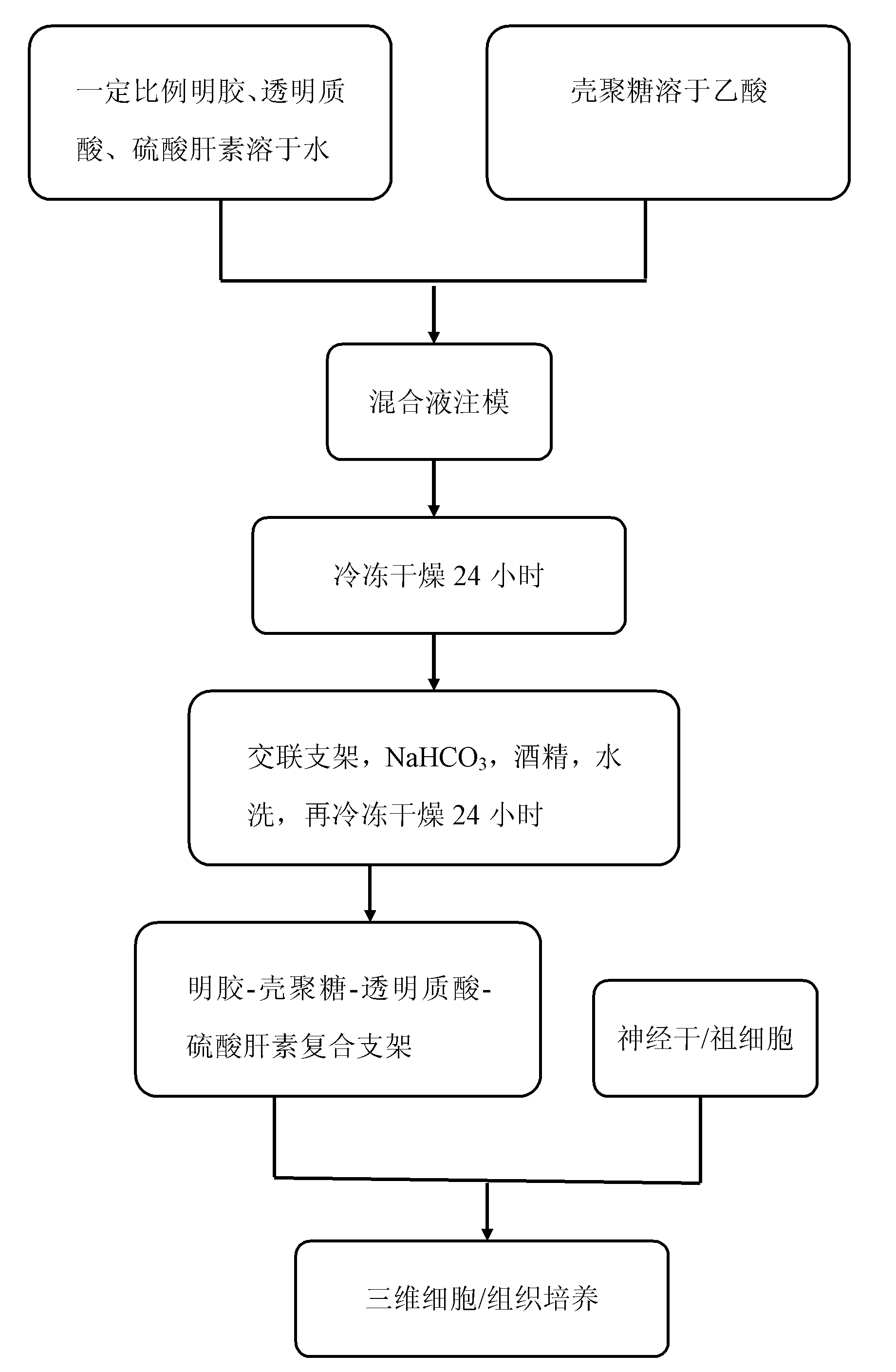Gelatin-chitosan-hyaluronic acid-heparan sulfate composite three-dimensional stent and preparation method thereof
A technology of hyaluronic acid and heparan sulfate, which is applied in the field of biomedicine to achieve the effect of uniform cell distribution and good proliferation and growth status
- Summary
- Abstract
- Description
- Claims
- Application Information
AI Technical Summary
Problems solved by technology
Method used
Image
Examples
example 1
[0033] In a 60℃ water bath, dissolve gelatin, hyaluronic acid, and heparin sulfate in water to make 1.4% gelatin (W / V), 0.028% hyaluronic acid (W / V), and heparin sulfate 0.028% (W / V) mixed solution; dissolve chitosan powder in 2% (V / V) acetic acid to make 1.4% (W / V) chitosan solution, centrifuge, remove slag, and degas; The two solutions are quickly mixed evenly at a ratio of 5:5. The mixed solution was injected into a 96-well plate at 200 μL / well, pre-frozen at -80°C for 4 hours, and freeze-dried for 24 hours. After the stent is formed, the stent is cross-linked at room temperature with a cross-linking agent containing 50 mmol / L 2-morpholine ethanesulfonic acid, 50 mmol / L carbodiimide, and 50 mmol / L N-hydroxysuccinimide in 40% ethanol for 6 hours. Remove the cross-linking agent, and use pH 7.4, 0.1mol / L Na 2 HPO 4 Incubate the buffer for 2h at room temperature to neutralize residual acetic acid; wash 4 times with 40% (V / V) ethanol, 30min / time, rinse with double distilled wat...
example 2
[0035] In a 60℃ water bath, dissolve gelatin, hyaluronic acid and heparin sulfate in water to make 1.8% gelatin (W / V), 0.036% hyaluronic acid (W / V), and heparin sulfate 0.036% (W / V) mixed solution; dissolve the chitosan powder in 2% (V / V) acetic acid to make a 1.8% (W / V) chitosan solution, centrifuge, remove slag, and degas; The two solutions are quickly mixed evenly at a ratio of 5:5. The mixed solution was injected into a 96-well plate at 200 μL / well, pre-frozen at -80°C for 4 hours, and freeze-dried for 24 hours. After the stent is formed, the stent is cross-linked at room temperature with a cross-linking agent containing 50 mmol / L 2-morpholine ethanesulfonic acid, 50 mmol / L carbodiimide, and 50 mmol / L N-hydroxysuccinimide in 40% ethanol for 6 hours. Remove the cross-linking agent, and use pH 7.4, 0.1mol / L Na 2 HPO 4 Incubate the buffer for 2h at room temperature to neutralize residual acetic acid; wash 4 times with 40% (V / V) ethanol, 30min / time, rinse with double distille...
example 3
[0037] In a 60℃ water bath, dissolve gelatin, hyaluronic acid, and heparin sulfate in water to prepare 2% gelatin (W / V), 0.04% hyaluronic acid (W / V), and heparin sulfate 0.04% (W / V) mixed solution; dissolve the chitosan powder in 2% (V / V) acetic acid to make a 2% (W / V) chitosan solution, centrifuge, remove slag, and degas; The two solutions are quickly mixed evenly at a ratio of 5:5. The mixed solution was injected into a 96-well plate at 200 μL / well, pre-frozen at -80°C for 4 hours, and freeze-dried for 24 hours. After the stent is formed, the stent is cross-linked at room temperature with a cross-linking agent containing 50 mmol / L 2-morpholine ethanesulfonic acid, 50 mmol / L carbodiimide, and 50 mmol / L N-hydroxysuccinimide in 40% ethanol for 6 hours. Remove the cross-linking agent, and use pH 7.4, 0.1mol / L Na 2 HPO 4 Incubate the buffer for 2h at room temperature to neutralize residual acetic acid; wash 4 times with 40% (V / V) ethanol, 30min / time, rinse with double distilled ...
PUM
| Property | Measurement | Unit |
|---|---|---|
| diameter | aaaaa | aaaaa |
| pore size | aaaaa | aaaaa |
| porosity | aaaaa | aaaaa |
Abstract
Description
Claims
Application Information
 Login to View More
Login to View More - R&D
- Intellectual Property
- Life Sciences
- Materials
- Tech Scout
- Unparalleled Data Quality
- Higher Quality Content
- 60% Fewer Hallucinations
Browse by: Latest US Patents, China's latest patents, Technical Efficacy Thesaurus, Application Domain, Technology Topic, Popular Technical Reports.
© 2025 PatSnap. All rights reserved.Legal|Privacy policy|Modern Slavery Act Transparency Statement|Sitemap|About US| Contact US: help@patsnap.com



